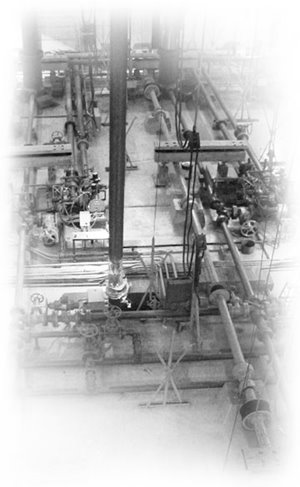#217 Radio City Music Hall Hydraulically Actuated Stage
1932
One of the largest movable stages in the world with innovative hydraulic equipment and controls, a forerunner of other stage designs as well as early aircraft carrier elevator systems
The music hall opened December 27, 1932, to acclaim as the "greatest achievement of the theatrical world" (New York Times). Popular Mechanics, April 1950, described it as a "hall of a thousand illusions." As it did then, the stage (100 feet wide) consists of four moveable platforms (two pistons each), one of which carries the orchestra’s bandwagon. The orchestra bandwagon is a self-propelled car, accommodating a 35-piece orchestra and its accouterments including two grand pianos. It typically travels some 200 feet a show, horizontally or vertically along an elevator shaft that allows it to shuttle back and forth from the sub-basement level or to the rear of the stage. "Jumping on the bandwagon" has never been so apropos.
The other three platform stages (each 70 feet wide and 12-16 feet deep) move, using the hydraulic system, independently or together from a point 27 feet below to 13 feet above the stage level, at a rate of 1 foot a second. When the three platform stages are at the same elevation, they can combine into a 43-foot diameter turntable that rotates (on rollers driven by a motor) in either direction. The staging then can be programmed to coordinate with the performances.
Originally, the eight-piston hydraulic system used synchronizing gears to automatically equalize the plungers. Special water (treated against bacteria) was pumped through pipes at 400 pounds pressure per square inch. The system used a 20,000-gallon pressure tank, built to raise or lower 190 tons of stage and could hoist an additional 96,000 pounds. The elevators were equipped with automatic pre-set stops or manually operated push-button stations, set from a bronze control panel.
An eight-month renovation of the entire hall was completed in the fall of 1999, which included an overhaul of the hydraulic system and its controls. Today, the staging is choreographed from a computer, which was designed and installed by J.R. Clancy of Syracuse, N.Y. The original control panel has been updated, however, and is operational.
Peter Clark
Between 1907 and his death in 1934 at the age of 56, Peter Clark became an internationally known stage and screen designer, with his offices in New York City. Florenz Ziefeld, Earl Carroll, and Sam Harris are among the producers for whom he and his staff created magnificent staging illusions. His obituary in the Great Neck News (August 1934) highlighted his history:
"Perhaps his most widely known invention was the hydraulic lift for elevating theatre orchestras or organ consoles to varying levels of a stage. Mr. Clark also perfected the elaborate system of counterweights used in all new theaters which have scene-shifting problems. His counterweights banished the clumsy backstage sandbags.
"Mr. Clark was born in New York on March 10, 1878. He attended public school and later took a job in the iron works of his father, Joseph Clark. He went to Cooper Union for a course in mechanical engineering. Having learned the iron business thoroughly, Mr. Clark and Hugh Laverly formed the stage construction and equipment firm of Clark & Laverly in 1905. Four years later Mr. Clark bought his partner out and renamed the firm Peter Clark, Inc."
Also noted in the conceptual design of the Radio City Music Hall staging are Eugene Braun, John D. Rockefeller, and Samuel Lionel Rothafel.
Landmark Location
Avenue of the Americas
between 50th and 51st Streets
New York, NY USA
Directions
The plaque is located below the stage with the hydraulic system.
Visiting Info
Tours to see the backstage are scheduled regularly.
Visit radiocity.com
Related Links
Ceremony Notes
November 12, 2001
Comments from Visitors/Members:
First nominated in 1983, this ceremony took place in conjunction with the International Mechanical Engineering Congress and Exposition 2001.
